Abstract
The river and lake chief system offers a valuable policy toolkit to mitigate the degradation of water ecology, thereby bolstering water resource management for sustainable water development in China. To evaluate the effects of implementation and improve policy, this study took Beijing as a typical case and conducted a quantitative assessment using multidimensional data. The findings suggest that while the river and lake chief system in Beijing is effective and has significantly contributed to the ecological management of rivers and lakes, there are also notable regional disparities and urban–rural divergences. In addition, human activities are the main sources of environmental pollution in rivers and lakes, which should be the focus of the river and lake chief system. The river and lake chief system needs to embed more public participation and cooperative governance. This research aids in better understanding China’s river and lake chief system for both researchers and practitioners, facilitating the advancement of the knowledge body of global water policy and governance.
1. Introduction
Water resources play a pivotal role in driving economic growth, urbanization, and sustainable development globally [,,]. Climate change will further exacerbate the issue [,,,]. Water distribution is not only a social, economic, and environmental challenge but also an important political issue []. China faces the perennial issues of scarcity, uneven distribution, severe pollution, and water resource waste []. On the one hand, China’s total water resources are notably inadequate, with a per-capita water resource of 2400 km3. This distribution is markedly uneven, exhibiting a scarcity in the northern and western regions compared to the more abundant conditions in the eastern areas []. On the other hand, rapid urbanization and industrialization have precipitated significant pollution of water resources. Consequently, water infrastructure projects and water policies, such as water transfer projects and integrated water resources management, are key ways to address the challenges [,,]. Upon scrutinizing the variations in water governance regimes across the globe, it is evident that a multitude of countries have adopted a range of strategies, including authoritarian regimes, decentralized regimes, and a combination of both models []. The river and lake chief system represents a pioneering, experiential, and unique policy in China’s water governance, highlighted by the centralized cross-departmental management regime from top to bottom. A place-based evaluation of the implementation effect of the river and lake chief system not only helps to better understand China’s river and lake chief system for both researchers and practitioners, but also helps to outline and improve the regime landscape of water authoritarian regimes.
The river and lake chief system consists of the river chief system and lake chief system and refers to an ecological innovation system in which the heads of local governments at all levels serve as river and lake chiefs responsible for organizing and leading the management and protection of the corresponding rivers and lakes []. In alignment with the Chinese administrative structure, the river and lake system is divided into four scales: provincial, municipal, county, and township levels. The roles of the river and lake chief system encompass (a) safeguarding water resources by fully implementing a rigorous water resource management system; (b) overseeing river and lake waters and shorelines, reinforcing spatial control over aquatic ecology, and strictly prohibiting encroachment on rivers and restoration of lakes; (c) preventing and controlling water pollution, coordinating both water and shore pollution control, investigating sources of pollution in rivers and lakes, and optimizing the layout of river outfalls; (d) managing the water environment to ensure the safety of drinking water sources and enhance treatment of polluted water bodies; (e) bolstering water ecological restoration, delineating the management scope of rivers and lakes, and strengthening the systematic management of mountains, water bodies, forests, fields, and lakes; and (f) supervising rivers and lakes while combating irregularities therein.
In November 2016, the Chinese state government officially issued the “Opinions on the Comprehensive Implementation of the River Chief System” to embark on implementing the river chief system. As of 2021, a total of 31 provinces have instituted the river and lake chief system, designating over 300,000 river and lake chiefs at provincial, municipal, county, and township levels. Additionally, the local government has designated 900,000 river and lake chiefs (including river patrols and river guards) at the village level and implemented a rigorous accountability system. Joint meetings between river basin management agencies and provincial river chief offices have been initiated in seven major river basins in China: the Yangtze River, Yellow River, Huai River, Hai River, Pearl River, Songhua River, and Taihu Lake. More than 20 provinces have established joint prevention and control mechanisms for rivers and lakes across provincial boundaries, explored the establishment of horizontal ecological compensation mechanisms, set up joint river and lake chiefs, and carried out joint inspection and enforcement. The establishment of the river and lake chief system has further strengthened the management and protection of rivers and lakes, is conducive to promoting sustainable water development, helps address China’s complex water problems, and also helps to improve China’s water governance system [,,].
Since the implementation of the river and lake chief system, more and more scholars have paid attention to studies of the river and lake chief system due to the system’s innovation and importance. Existing research predominantly centers on policy implementation, performance assessment, and management methodologies. Several studies have delved into the inception, roles, outcomes, merits, and limitations of China’s river and lake chief system [,]. Furthermore, numerous scholars recognize the significance of effective communication and coordination in the context of transboundary rivers and have suggested the establishment of a multi-support river chief system to enhance the long-term restoration and management efficacy of China’s transboundary rivers []. Some researchers have underscored the significance of public engagement in the river and lake chief systems []. Performance metrics have consistently been pivotal in the examination of river and lake chief systems. Xu et al. (2020) evaluated the effectiveness of the river chief system with the comparison of the water pollution in Chaohu Lake under the river chief system and without the river chief system through a differential game model under random interference factors []. Liu et al. (2019) examined the feasibility and weaknesses in the implementation of the river chief system based on the case study of Foshan []. Tang et al. (2020) took the Chaohu Lake basin as a case and evaluated its water ecological security before and after the implementation of the river chief system []. Zuo et al. (2021) assessed regional-scale water-resource-carrying capacity by applying fuzzy multiple-attribute decision-making and scenario simulation methods []. Zhang et al. (2021) established an evaluation system for the green development of small hydropower stations under the river chief system []. While the findings from these studies can underscore the influence of the river and lake chief system, they are confined to a specific basin or isolated case. This overlooks the potential impact on a regional scale and the public’s response to such systems.
Beijing, the capital city of China, had articulated a strategic plan for the implementation of its river and lake chief system in 2020, aimed at enhancing the ecological and environmental management of rivers and lakes within the city. This plan includes the establishment of an organizational structure for river and lake chiefs at the city, district, and township levels, along with mechanisms for examination, supervision, and assessment. This study undertook a quantitative evaluation of Beijing’s river and lake chief system using multifaceted dimensions, including the results from a Special Examination for Ecological Environment of Rivers and Lakes (SE3RL) conducted in Beijing in 2021, changes in the ecological environment of rivers and lakes in Beijing from 2019 to 2021, and a comparative analysis between SE3RL data and Swift Response to Public Complains (SRPC) system data in Beijing.
This study aims to shed light on the sustainable water regime in the context of China’s authoritarian river and lake governance by assessing the evolution of the regional river and lake’s ecological water environment, thereby furnishing empirical evidence for sustainable water governance and proposing pertinent governance recommendations. The highlights of this study are threefold: firstly, this study provides a decision-making basis for the improvement of water governance in Beijing through empirical evidence and analysis; secondly, this study enriches the human–water relationship discipline through delving into the river and lake chief system by utilizing a combination of SE3RL and SRPC data; and finally, this study provides valuable insights for researchers and practitioners seeking to understand China’s river and lake chief system policy. The remainder of this article is structured as follows: The next section delineates the research method and associated data; it follows a presentation of the results in the third section and discusses them in the penultimate section; the final section concludes the study.
2. Materials and Methods
2.1. Study Area
In China, approximately 400 out of the 669 cities are facing water supply insufficiencies, with 110 experiencing acute shortages. These cities predominantly reside in the semi-arid and arid regions of north and northwest China. Notably, the water scarcity in northern China has emerged as a significant impediment to the nation’s economic development []. Consequently, Beijing was chosen as the representative case for this study.
Beijing, the political and cultural center of China, spans an area of 16,410 km2. In 2021, it boasted a population of 21.88 million and a GDP of CNY 4026 billion. The city is home to 425 rivers, collectively spanning 6413 km in length. Of these, 166 are operational, with a combined length of 3469 km. Beijing’s five primary river basins include the Chaobai, Jiyun, Yongding, Beiyun, and Daqing (Figure 1). The Chaobai system extends 1248.14 km, representing 55.7% of the total river system length. In contrast, the Jiyun system is the smallest at 237.62 km. Upon further subdivision and integration with reservoir basins, this can be segmented into 15 distinct basins: Beiyun River Basin, Chaobai River Basin, Liangshui River Basin, Feng River Basin, Daqing River Basin, Jiyun River Basin, Yongding River (mountain section) Basin, Yongding River (plain section) Basin, Qing River Basin, Urban Rivers and Lake Basins, Shahe reservoir Basin, Miyun reservoir Basin, Guanting reservoir, Shisanling reservoir, and Huairou reservoir. This study utilizes this classification framework. However, the local water resources are not sufficient to support the residents’ living and economic development, and China’s government has constructed the South-to-North Water Diversion Project for long-distance water transfer, which has now basically solved the water supply. Therefore, effective management of water resources is particularly important for Beijing.
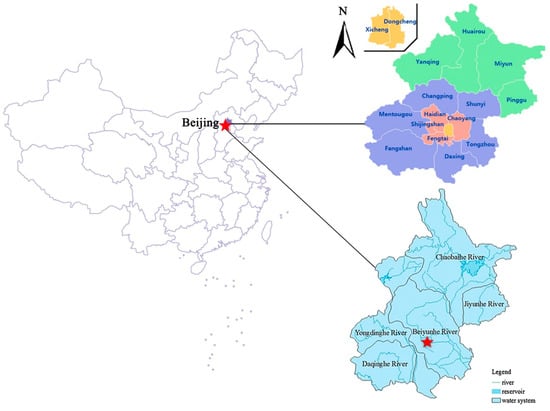
Figure 1.
Location and river system in Beijing. Red star: China’s capital.
2.2. Research Method and Data Sources
This study utilized the case study method, a scientific analysis approach that provides an in-depth and meticulous examination of representative phenomena to achieve a comprehensive understanding []. Unlike other methods, the case study approach does not impose control over the phenomenon’s background or interfere with its evolving process. Instead, it leverages the collected data to discern logical relationships between events []. As an empirical research technique, this method aids researchers in acquiring objective information about entities and employing induction or interpretation to acquire knowledge []. Contextualized, specific case studies facilitate inquiries into what and why and are subsequently classified as descriptive, explanatory, evaluative, or exploratory based on the research objective. However, the case study method also has some drawbacks, such as subjectivity, requiring a lot of time and resources, and poor comparability of results.
The primary data sources for this study encompass the Beijing Special Examination for Ecological Environment of Rivers and Lakes (SE3RL) and Beijing’s SRPC issues pertaining to rivers and lakes. In recent years, the Beijing Municipal Government has persistently undertaken third-party assessments of the ecological environment within these bodies of water. To be specific, the Beijing Municipal Water Bureau commissioned a third-party organization to conduct SE3RL of rivers, lakes, and reservoirs in 16 districts of Beijing in 2021. During the specified period, a third-party organization established 2619 checkpoints across Beijing. These comprised 1961 river checkpoints, 53 lake checkpoints, and 605 reservoir checkpoints. The third-party organization conducted monthly SE3RL at these checkpoints in Beijing, utilizing tools such as drones and water quality detectors. Furthermore, they consistently urged the Beijing Municipal Water Bureau to fix these issues on a quarterly basis.
The Swift Response to Public Complains (SRPC) system, a significant governmental reform initiative in Beijing, was launched by the Beijing Municipal Government in 2019. Based on the 12,345 hotline system in Beijing, the SRPC system expands the scope of services, adds functions, revamps the process, and establishes a mechanism to directly assign the public complaints to the corresponding streets, towns, municipal departments, and public service enterprises, and requires these complaints to be completed within a specified time frame. Prior to the implementation of the SRPC system, poor coordination between government departments and limited data management capabilities led to over 100 local and departmental hotlines in Beijing being managed by multiple entities. This resulted in ineffective data integration and utilization and delayed resolution of public complaints. The SRPC system, however, takes the people’s livelihood as its foundation, integrating the resources of Beijing’s government hotlines and promoting the enhancement of local grassroots governance. The data generated from the SRPC system provides insights into the basic demands of the populace towards the government. Furthermore, public opinions related to the ecological environment of rivers and lakes serve as an indicator of the public’s evaluation of their participation and the effectiveness of the river and lake chief system. When combined with research data, the implementation effect of the river and lake chief system is reflected from multiple angles.
In sum, we conducted a cross-sectional analysis utilizing 2021 annual SE3RL data to pinpoint existing issues. Subsequently, we evaluated the system’s implementation efficacy by comparing it with data from 2019–2020. Ultimately, we integrated river- and lake-related concerns from Beijing’s SRPC to provide a comprehensive assessment of the effectiveness of the river and lake system’s implementation.
3. Results
3.1. The Findings of the Case Study
Between January and December 2021, we conducted an extensive examination of 425 rivers, 85 reservoirs, 41 lakes, and 142 black and odorous water bodies. Additionally, the authors assessed small and micro-water bodies, culminating in a total diagnosis of 2907 sites exhibiting water governance issues. The detailed findings are presented below.
3.1.1. Types of Problems
In 2021, Beijing’s SE3RL identified several types of issues, as follows: 1668 (57.38%) sites exhibited stacking of garbage and dirt; 397 (13.66%) were characterized by small to micro-water bodies that either had been completely remediated or posed no problems; 243 (8.36%) were found to be discharging sewage; 147 (5.06%) presented abnormal water bodies; 97 (3.34%) were associated with damaged facilities; 92 (3.16%) were public signs; 75 (2.58%) had floating objects; 72 (2.48%) involved occupied rivers and lakes; 68 (2.33%) pertained to social behaviors; and 48 (1.65%) were instances of illegal constructions (Figure 2).
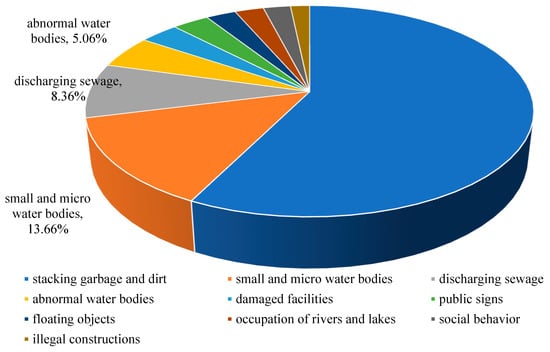
Figure 2.
Types of problems found in the SE3RL in Beijing in 2021. Data source: SE3RL and SRPC of Beijing in 2021.
3.1.2. Regional Divergences
In 2021, the top three districts with more problems found in the city’s river and lake environmental inspections were Tongzhou District, Changping District, and Daxing District, with 429, 308, and 276, respectively. Conversely, the Shijingshan District, Dongcheng District, and Xicheng District were identified as the least problematic, registering 7, 12, and 20, respectively (Figure 3).
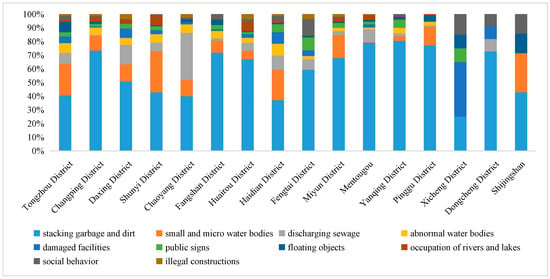
Figure 3.
Problems in the administrative district of Beijing in 2021. Data source: SE3RL and SRPC of Beijing in 2021.
In terms of various problem indicators, the most problematic districts in terms of accumulation of garbage and dirt were Changping District, Tongzhou District, and Fangshan District, with respective counts of 226, 174, and 163. Conversely, the least problematic districts were Shijingshan District, Xicheng District, and Dongcheng District, with counts of 3, 5, and 8, respectively.
The three districts in the city exhibiting the highest prevalence of small and micro-water body issues were Tongzhou District, Shunyi District, and Haidian District, with respective counts of 100, 78, and 39. In contrast, Mentougou district was found to have only one identified issue, while both Xicheng and Fengtai districts remained free from any such problems.
The sewage-related issues were most prevalent in the Chaoyang, Daxing, and Tongzhou districts, with respective counts of 82, 39, and 33. In contrast, Dongcheng and Pinggu districts exhibited a single issue, while Xicheng and Shijingshan districts remained free from any such problems.
The city’s three primary districts, Tongzhou, Changping, and Shunyi, exhibited the highest incidence of abnormal water issues, with counts of 31, 17, and 16, respectively. In contrast, Dongcheng District was the only district to report a single problem, while Xicheng and Shijingshan Districts remained free from any such issues.
3.1.3. Watersheds
A range of issues are dispersed across the city’s 15 river basins. The North Canal Basin, Liangshui River Basin, and Chaobai River Basin emerged as the top three with a high number of problems, recording 432, 325, and 282 issues, respectively. In contrast, the Qinghe River Basin, Jingmi Diversion Canal, Huairou Reservoir Basin, and Xialing Reservoir Basin were identified as having the fewest problems, with 61, 78, and 85 issues, respectively (Figure 4).
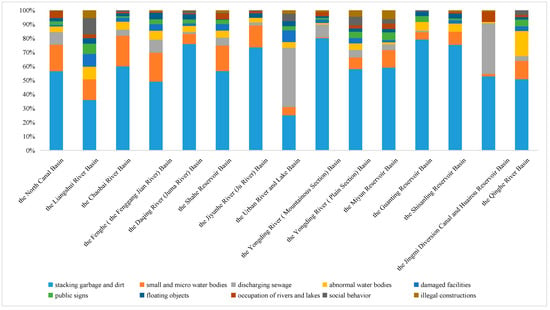
Figure 4.
Problems with basins in Beijing in 2021. Data source: SE3RL and SRPC of Beijing in 2021.
In terms of indicator types, the North Canal Basin, Daqing River (also known as the Juma River) Basin, and Chaobai River Basin exhibited the highest incidences of garbage and dirt stacking problems, with counts of 244, 211, and 169, respectively. Conversely, the Qing River Basin, Urban Rivers and Lake Basins, Beijing–Mijiang Diversion Canal, and Huairou Reservoir Basin demonstrated the lowest instances of such issues, registering at 31, 42, and 57, respectively.
The three basins exhibiting the most significant issues related to small and micro-water bodies were the North Canal, Chaobai River, and Fenghe basins, each accounting for 82, 62, and 58, respectively. Conversely, the Yongding River (mountain section), Jingmi Diversion Canal, Huairou Reservoir Basin, and Guan Hall Reservoir Basin presented the least problems, with counts of 1, 2, and 5, respectively.
The most problematic basins in terms of sewage discharge were the Urban Rivers and Lake Basins, Liangshui River Basin, and North Canal Basin, each accounting for 71, 39, and 39, respectively. Conversely, the least problematic basins were the Shisanling Lakes Reservoir Basin, Guanshui Reservoir Basin, and Qing River Basin, all with zero, one, and two issues, respectively.
The most problematic water bodies were observed in the Liangshui River Basin, Fenghe Basin, and North Canal Basin, with a respective count of 26, 18, and 17. In contrast, the Jingmi Diversion, Huairou Reservoir Basin, Yongding River (mountain section) Basin, and Miyun Reservoir Basin exhibited the fewest issues, each having only one abnormality.
3.1.4. Monthly Distribution
The period of the year with the highest incidence of problems was observed from March to August, with March recording the highest number of incidents (344). Conversely, January, November, and December witnessed a relatively lower number of reported issues (Figure 5). The litter category experienced a significant surge in the months of March, April, and May, coinciding with the peak bloom of spring and an uptick in outdoor river swimmers. June, July, and August were characterized by elevated temperatures, leading to an increase in water quality abnormalities. It is evident that seasonal variations significantly influence both the frequency and nature of these issues across different months.
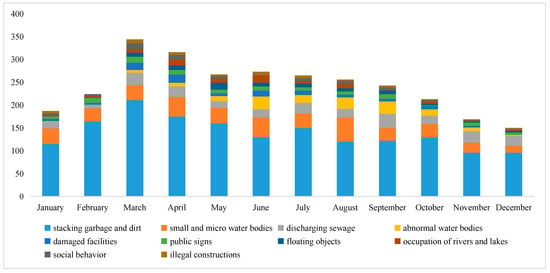
Figure 5.
Problems of each month in 2021. Data source: SE3RL and SRPC of Beijing in 2021.
3.2. Evolution of Riverine and Lake Ecosystems in Beijing from 2019 to 2021
3.2.1. Distribution and Evolution of Problem Types
Between 2019 and 2021, a total of 13,507 issues were identified in Beijing’s rivers and lakes: 4946 in 2019; 5654 in 2020; and 2907 in 2021. Notably, the number of problems observed in 2021 marked a significant decline compared to the preceding two years, as evidenced by an average annual reduction of 17.13% (Figure 6).
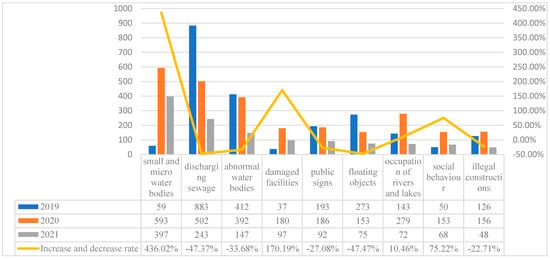
Figure 6.
Distribution of problems by type from 2019 to 2021. Data source: SE3RL and SRPC of Beijing in 2021.
In terms of problem types, over 50% (55.51%) of environmental issues in rivers and lakes are attributed to the accumulation of garbage and dirt. This is followed by sewage discharges and small and micro-water bodies, which account for 12.05% and 7.77%, respectively. Six problem types have demonstrated a decreasing annual trend: sewage discharges, floating objects, abnormal water bodies, river chief information public signs, illegal constructions, and garbage and dirt accumulation. Since June 2020, the scope of inspections has expanded significantly, particularly focusing on small and micro-water bodies. This led to an exponential increase in this category. Additionally, categories such as damaged facilities, occupation of rivers and lakes, and social behavior have been incorporated into the inspection process. These three types of problems saw significant growth in 2020, resulting in a positive average annual rate of increase or decrease from 2019 to 2021. However, all problem types experienced a significant decline in 2021. This can be attributed to the implementation of dragnet examinations in 2020, which documented most of the city’s river and lake issues. Subsequent active rectification efforts by districts ensured that the number of problems remained within acceptable limits by 2021, with no further significant rebound observed.
3.2.2. Distribution and Evolution of Regions
From 2019 to 2021, the Tongzhou District, Changping District, and Daxing District emerged as the top three districts with the highest number of environmental inspection issues in relation to rivers and lakes within the city. These were recorded at 1746, 1495, and 1254, respectively (Figure 7). Conversely, the Dongcheng District, Xicheng District, and Shijingshan District exhibited the lowest number of such issues. These were found to be 96, 99, and 104, respectively. A noteworthy annual decline was observed across all 16 districts in terms of the number of problems identified. The average rate of this decline for each district was calculated to be 22.39%. Notably, the largest average annual decrease was registered at 54.86% in the Shijingshan District, while the smallest was a mere 0.58% in the Shunyi District. Within the Shunyi District alone, there were 555 small and micro-water bodies discovered, constituting one-fifth of the city’s total. It is important to note that an increase in the scope of inspection for these small and micro-water bodies in 2020 led to a significant rise in the number of problems identified in Shunyi District. This resulted in a marginal average annual decline in the number of problems.
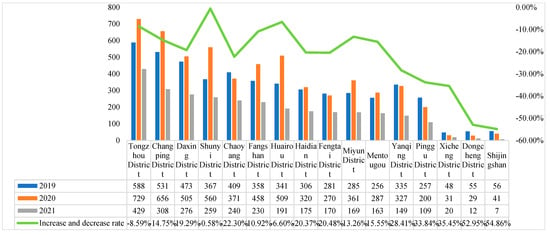
Figure 7.
Distribution of problems by region from 2019 to 2021. Data source: SE3RL and SRPC of Beijing in 2021.
3.2.3. Distribution and Evolution of Basins
Between 2019 and 2021, environmental issues in the city’s rivers and lakes were identified across 15 distinct basins. The North Canal Basin, Fenghe Basin, and Liangshui River Basin emerged as the most problematic, recording 2099, 1465, and 1312 issues, respectively (Figure 8). In contrast, the Qinghe River Basin, Shisanling Reservoir Basin, Jingmi Diversion Canal, and Huairou Reservoir Basin reported the fewest problems at 196, 326, and 442, respectively. The annual average fluctuation in the number of detected issues across the city’s 13 basins is negative, suggesting a gradual decline in river basin-specific problems. However, the Miyun Reservoir Basin, Shisanling Reservoir Basin, and Qing River Basin exhibit positive annual fluctuations. Notably, the Miyun Reservoir Basin and Qinghe River Basin are characterized by their relatively small basin sizes and fewer associated issues. While there is minimal year-to-year variation in problem count, the 2020 data point represents an increase due to alterations in inspection methodologies and scope. Specifically, the larger Miyun Reservoir Basin experienced a significant surge in problem numbers—doubling—attributed to changes in inspection methods and scope in 2020. This led to a more pronounced average annual increase in problem counts.
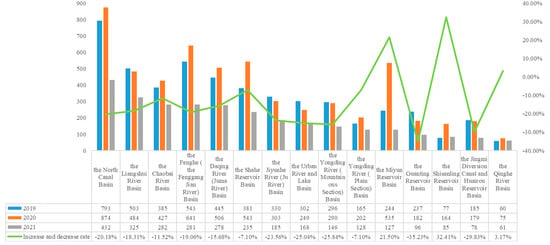
Figure 8.
Distribution of problems by basin from 2019 to 2021. Data source: SE3RL and SRPC of Beijing in 2021.
3.2.4. Distribution and Evolution in Towns
Between 2019 and 2021, a total of 300 towns in the city were identified as having issues related to rivers and lakes. Of these, the top 15 towns with the most problems were Kuoxian Town (Tongzhou District), Xililing Town (Changping District), Qingyundian Town (Daxing District), Songzhuang Town (Tongzhou District), Changziying Town (Daxing District), Xiaotangshan Town (Changping District), Majuqiao Town (Tongzhou District), Xixiwang Town (Haidian District), Zhangjiawan Town (Tongzhou District), Liqiao Town (Shunyi District), Sujiatuo Town (Haidian District), Taihu Town (Tongzhou District), Wanpingcheng District (Fangshan District), Yongledian Town (Tongzhou District), and Wangzuo Town (Fangshan District) (Figure 9). Based on the river and lake inspection data from 2019 to 2021, the towns with the highest number of river and lake issues each year include Kuoxian Town in Tongzhou District, Xailing Town in Changping District, and Songzhuang Town in Tongzhou District. These three towns are ranked highly and must prioritize improving their environmental management of rivers and lakes. Notably, six of the city’s 15 towns with the highest number of problems are located in Tongzhou District.
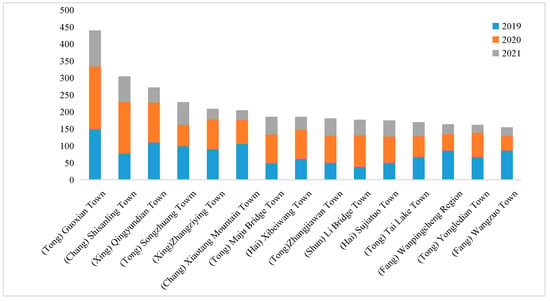
Figure 9.
Distribution of problems by town from 2019 to 2021. Data source: SE3RL and SRPC of Beijing in 2021.
3.3. Comparison of SE3RL and SRPC in Beijing
The SE3RL serves as a crucial tool for the examination, assessment, and encouragement of river chiefs at all scales to fulfill their responsibilities. It also provides insights into the advancement of regional rivers’ and lakes’ water environment management. The SRPC, on the other hand, offers a significant reflection of the efficacy of protection efforts for rivers and lakes by presenting issues related to the water environment from the public’s viewpoint. The integration of these two tools allows for a comprehensive evaluation of the river and lake chief system from various perspectives.
3.3.1. Consistency in Water Governance Issues
In terms of the classification of river and lake issues, the 2021 environmental examination data for rivers and lakes, along with complaint data, align with nine prevalent problem types. These include common environmental concerns such as garbage and dirt accumulation, abnormal water bodies, sewage discharges, facility damage, floating objects, social behavior issues, public signage, occupation of rivers and lakes, and illegal construction (Figure 10). The comparative analysis of the data reveals that the number of nine types of problems is roughly the same, and all of them are mostly in the category of stacking garbage and dirt, with 1668 and 555 problems found, respectively. The types of problems are different in that there are weed-type problems in the SRPC and there are small and micro-water body problems in the examination data. Social behavior issues were relatively more frequent in complaints received, ranking second. However, such issues were less common in the examination data, following the small water body issues. The volume of public complaints regarding sewage discharge and abnormal water bodies surpasses the number of such issues detected during inspections. This suggests that public concern about water quality and sewage issues is high, underscoring the need for increased focus on early detection of these problems.
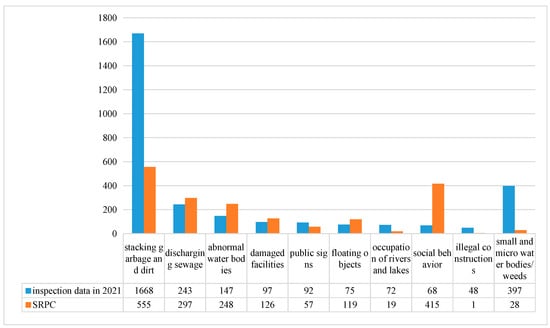
Figure 10.
Comparison of problems by type. Data source: SE3RL and SRPC of Beijing in 2021.
3.3.2. Distribution and Evolution of Problem Types
Data from the river and lake environmental examinations, along with those from the SRPC received in 2021, indicate that environmental issues across all districts within the city are prevalent. However, Tongzhou District exhibits the highest number of problems, with 429 identified in the river and 193 in the lake. This is closely followed by Changping District, which reported 308 and 188 problems, respectively (Figure 11). The least number of environmental issues were found in Shijingshan District, with 7 and 13 problems identified in the river and lake, respectively, followed by Dongcheng District. Furthermore, it was observed that the number of inspection problems per district generally exceeded that of the SRPC. The overall ratio between these two figures was 1.45 times higher than the SPRC’s count, with the most significant discrepancy being a 2.22-fold increase in Tongzhou District. The smallest difference was noted in Miyun District, where only two cases were missing between the two datasets. Notably, while both Dongcheng and Shijingshan District had more problems on the SPRC than their respective inspection data, this discrepancy was limited to six cases. Both districts demonstrated fewer water environment issues in their rivers and lakes.
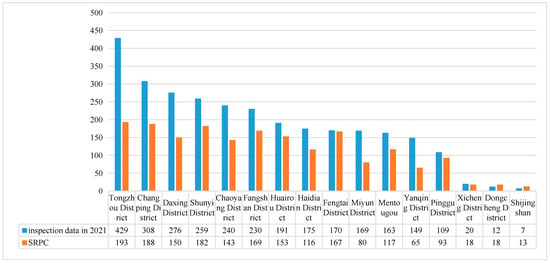
Figure 11.
Comparison of problems by region. Data source: SE3RL and SRPC of Beijing in 2021.
3.3.3. The Difference between Urban and Rural Regions
In 2021, 252 and 282 towns were included in the SE3RL and SPRC datasets, respectively. The most problematic towns according to the 2021 river and lake environmental assessment data are Kuoxian Town (Tongzhou District), Xililing Town (Changping District), and Songzhuang Town (Tongzhou District). Similarly, the SPRC dataset identifies Shahe Town (Changping District), Songzhuang Town (Tongzhou District), and Changyang Town (Fangshan District) as having the highest number of issues, as shown in Table 1. Both datasets reveal that Songzhuang, Zhangjiawan, Taihu, and Xijizhen in the Tongzhou District, along with Miaofengshan in the Mentougou District, are consistently ranked within the top 20. These high-ranking streets and towns should be prioritized for future river and lake environmental management initiatives. As a sub-center of the capital city, the Tongzhou District bears particular responsibility for managing and preserving its river and lake water environments. Notably, frequent issues in parts of the Tongzhou District suggest that improvements are needed in sewage collection, garbage disposal, storage, and transportation systems both within urban areas and rural fringes.

Table 1.
Comparison of the top 10 problems by town.
4. Conclusions and Discussion
The human–water relationship is extremely complex in the context of human-induced climate change [,,,], and the human–water relationship discipline is a powerful tool to solve difficult problems caused by the complexity []. The river and lake chief system, an innovative water governance policy proposed by China’s government in response to escalating water shortages and pollution crises, seeks to enhance the ecology of rivers and lakes and contributes to the human-water relationship discipline while bolstering their protection and management. A timely and efficacious evaluation of this system is pivotal for refining its policies and advancing water governance. The most immediate impact of the river and lake chief system’s implementation is the amelioration of the ecological environment of rivers and lakes, coupled with an increase in public satisfaction. However, this latter outcome is frequently lacking. This study conducted a comprehensive assessment of the effects of the river and lake chief system in Beijing, utilizing a combination of SE3RL and SRPC data.
The findings indicate that the river and lake chief system in Beijing is effective and has significantly contributed to the ecological management of rivers and lakes. The data and analysis presented above indicate that, despite the current ecological challenges facing river and lake governance in Beijing, these issues are not severe. For example, 2907 problems were found in 693 rivers, lakes, and reservoirs, all of which were small issues. A comparable trend was observed in the SRPC. Furthermore, there was a marked decline in the ecological issues of rivers and lakes in Beijing from 2019 to 2021, which suggests that the river and lake chief systems in Beijing are apparently effective.
The implementation of the river and lake chief system in Beijing exhibits several distinct characteristics. Firstly, the ecological issues concerning rivers and lakes in Beijing exhibit significant spatial and temporal variations. This difference is not only related to the natural environment, such as terrain and hydrology, but also has an important correlation with economic and social development. The management regimes for these bodies of water are far from ideal in Tongzhou, Changping, and Daxing Districts, with Tongzhou exhibiting the most problems. As a sub-center of Beijing, Tongzhou has experienced rapid development in recent years through economic and industrial dynamics in the form of numerous industrial parks, boasting a population of 1.843 million and a GDP of CNY 120.63 billion in 2021. It also serves as the terminus of the Grand Canal. This rapid economic growth and urbanization have significantly impacted the governance of rivers and lakes. Secondly, there is a substantial urban-rural disparity in river and lake governance. This disparity has been a significant challenge in China’s economic development and urbanization, and it deeply affects the implementation of the river and lake chief system. The system tends to favor urban areas, neglecting water ecology management in rural areas, where the water governance performance is far from satisfactory. Therefore, future focus should be directed towards addressing this urban-rural disparity within the river and lake chief system. Moreover, the ecological issues associated with these basins are intrinsically linked to their geographical location. Specifically, those that flow through urban areas, particularly industrial parks, exhibit the most significant challenges. This underscores that in a metropolis like Beijing, the deterioration of river and lake ecology is the outcome of a myriad of factors. However, human activities, encompassing economic, social, and general livelihood considerations, stand out as the primary contributors to environmental contamination in rivers and lakes. Consequently, this should be another focal point within the river and lake management system.
To address the prevailing challenges in the implementation of the river and lake chief system, local governments can adopt several measures. Firstly, the system’s implementation should prioritize key problematic areas and basins, undertaking targeted remediation initiatives. Emphasis should be placed on leveraging new technologies to facilitate comprehensive ecological management of rivers and lakes through a combined approach of technology and management []. Secondly, the prevalent issue of insufficient supervision is a significant contributor to recurrent environmental issues in rivers and lakes. Consequently, there is an imperative need to standardize the roles of river chiefs and bolster the supervisory capabilities of grassroots river and lake chiefs []. Enhancing the expertise of river and lake chiefs and incorporating domain experts in river and lake ecology will ensure that the river and lake chief system assumes a more robust role in supervising the water environments of rivers and lakes. Lastly, fostering public engagement and establishing cooperative governance structures are crucial []. Currently, the river and lake chief system predominantly falls under the government’s purview, with limited public participation. Hence, it is essential to establish a cooperative governance framework for rivers and lakes, encourage public involvement in river and lake governance, and further amplify the public’s commitment to safeguarding the water environment.
The policy implications of this study are as follows: First, the government, including the Ministry of Water Resources, the National Development and Reform Commission, and the Ministry of Natural Resources, should fully consider regional differences and urban-rural differences when formulating water policies. Second, government departments need to pay more attention to public response, public expectation, and public participation in the formulation of water policies through various approaches. Third, the government’s governance capacity and governance system need to be improved, such as through collaborative governance and adaptive governance []. Finally, another area that warrants further exploration is the influence of the river and lake chief system on achieving carbon neutrality and peaking carbon emissions []. It is imperative for governments to recognize the synergistic effect of river and lake conservation on reducing greenhouse gas emissions and addressing climate change. They should encourage the integrated development of ecological protection and environmental preservation within basins, as well as the adoption of green and low-carbon development strategies.
To be honest, the river and lake chief system has proven effective in enhancing the ecology of rivers and lakes in Beijing. However, this impact is partially attributed to Beijing’s status as China’s capital, which brings policy priorities, ample budgets, and high-level political coordination. Consequently, Beijing’s experience may not be directly applicable to other regions. Therefore, future research should conduct a national assessment of the river and lake chief system’s effectiveness. This provides an opportunity for comparative analysis and heuristic theory-building across a broader spectrum of cities and contexts []. Moreover, it is admitted that the river and lake chief system, introduced in 2007, is a pioneering approach to water governance in China, characterized by Chinese authoritarianism and hierarchy governance. However, the peculiarities of the river and lake chief system and its governance empirical explorations should never be overestimated and overemphasized. Consequently, the research advocates for a more detailed comparative study that transcends localized analyses to encompass conjunctural comparisons across both the global south and north.
Author Contributions
Conceptualization, T.S. and Z.C.; methodology, Y.Z.; software, M.W.; validation, T.S. and Z.C.; formal analysis, Y.Z.; investigation, M.W.; data curation, M.W.; writing—original draft preparation, Z.C.; writing—review and editing, T.S.; visualization, Y.Z.; supervision, T.S.; project administration, Z.C.; funding acquisition, Z.C. All authors have read and agreed to the published version of the manuscript.
Funding
The research is sponsored by the grants of the National Natural Science Foundation of China (No. 42171180 and No. 42271185) and the Major Program of Philosophy and Social Science of the Chinese Ministry of Education (No. 21JZD034).
Data Availability Statement
Data are contained within the article.
Conflicts of Interest
The authors declare no conflicts of interest.
References
- OECD Water Governance Programme. Principles of Water Governance. 2018. Available online: http://www.oecd.org/env/watergovernanceprogramme.htm (accessed on 2 February 2023).
- Furlong, C.; Gan, K.; De Silva, S. Governance of integrated urban water management in Melbourne, Australia. Util. Pol. 2016, 43, 48–58. [Google Scholar] [CrossRef]
- Cruz, N.; Marques, R. Scorecards for sustainable local governments. Cities 2014, 39, 165–170. [Google Scholar] [CrossRef]
- Zhang, R.; Qi, J.; Leng, S.; Wang, Q. Long-Term Vegetation Phenology Changes and Responses to Preseason Temperature and Precipitation in Northern China. Remote Sens. 2022, 14, 1396. [Google Scholar] [CrossRef]
- Xu, F.; Qu, Y.; Bento, V.A.; Song, H.; Qiu, J.; Qi, J.; Wan, L.; Zhang, R.; Miao, L.; Zhang, X.; et al. Understanding climate change impacts on drought in China over the 21st century: A multi-model assessment from CMIP6. NPJ Clim. Atmos. Sci. 2024, 7, 32. [Google Scholar] [CrossRef]
- Wan, L.; Bento, V.; Qu, Y.; Qiu, J.; Song, H.; Zhang, R.; Wu, X.; Xu, F.; Lu, J.; Wang, Q. Drought characteristics and dominant factors across China: Insights from high-resolution daily SPEI dataset between 1979 and 2018. Sci. Total Environ. 2023, 901, 166362. [Google Scholar] [CrossRef]
- Wu, X.; Zhang, R.; Bento, V.A.; Leng, S.; Qi, J.; Zeng, J.; Wang, Q. The Effect of Drought on Vegetation Gross Primary Productivity under Different Vegetation Types across China from 2001 to 2020. Remote Sens. 2022, 14, 4658. [Google Scholar] [CrossRef]
- Talozi, S.; Altz-Stamm, A.; Hussein, H.; Reich, P. What constitutes an equitable water share? A reassessment of equitable apportionment in the Jordan–Israel water agreement 25 years later. Water Policy 2019, 21, 911–933. [Google Scholar] [CrossRef]
- Shen, D. Water Resources Management of the People’s Republic of China: Framework, Reform and Implementation; Dinar, A., Ed.; Springer: Cham, Switzerland, 2020; Volume 25, pp. 193–208. Available online: https://books.google.com/books/about/Water_Resources_Management_of_the_People.html?hl=no&id=E7MKEAAAQBAJ (accessed on 2 February 2023).
- Wang, X.; Xiao, X.; Zou, Z.; Dong, J.; Qin, Y.; Doughty, R.B.; Menarguez, M.A.; Chen, B.; Wang, J.; Ye, H.; et al. Gainers and losers of surface and terrestrial water resources in China during 1989–2016. Nat. Commun. 2020, 11, 3471. [Google Scholar] [CrossRef]
- Liptrot, T.; Hussein, H. Between regulation and targeted expropriation: Rural-to-urban groundwater reallocation in Jordan. Water Altern. 2020, 13, 864–885. [Google Scholar]
- Jia, S.; Zhu, W. China’s achievements of water governance over the past seven decades. Int. J. Water Resour. Dev. 2020, 36, 292–310. [Google Scholar] [CrossRef]
- Liu, T.; Zhang, W.; Wang, R.Y. How does the Chinese government improve connectivity in water governance? A qualitative systematic review. Int. J. Water Resour. Dev. 2020, 38, 717–735. [Google Scholar] [CrossRef]
- Hurlbert, M.A.; Diaz, H. Water Governance in Chile and Canada: A Comparison of Adaptive Characteristics. Ecol. Soc. 2013, 18, 61. [Google Scholar] [CrossRef]
- Wang, Y.; Chen, X. River chief system as a collaborative water governance approach in China. Int. J. Water Resour. Dev. 2020, 36, 610–630. [Google Scholar] [CrossRef]
- Jia, S.; Li, D. Evolution of Water Governance in China. J. Water Resour. Plan. Manag. 2021, 147, 04021050. [Google Scholar] [CrossRef]
- Li, Y.; Tong, J.; Wang, L. Full implementation of the river chief system in China: Outcome and weakness. Sustainability 2020, 12, 3754. [Google Scholar] [CrossRef]
- Wang, L.F.; Li, Y. Chinese scheme to resolve the current complicated water issues: River chief system (RCS). IOP Conf. Ser. Earth Environ. Sci. 2018, 191, 012019. [Google Scholar] [CrossRef]
- Li, Z.; Zhang, X.; Jiang, R.; Huang, X. Establishing Multi-support River Chief System (RCS) to Achieve Long-term Restoration and Management Effectiveness of Transboundary Rivers. IOP Conf. Ser. Earth Environ. Sci. 2020, 455, 012191. [Google Scholar] [CrossRef]
- Wu, C.; Ju, M.; Wang, L.; Gu, X.; Jiang, C. Public participation of the river chief system in china: Current trends, problems, and perspectives. Water 2020, 12, 3496. [Google Scholar] [CrossRef]
- Xu, X.; Wu, F.; Zhang, L.; Gao, X. Assessing the effect of the Chinese river chief policy for water pollution control under uncertainty—Using chaohu lake as a case. Int. J. Environ. Res. Public Health 2020, 17, 3103. [Google Scholar] [CrossRef]
- Liu, H.; Chen, Y.D.; Liu, T.; Lin, L. The river chief system and river pollution control in China: A case study of Foshan. Water 2019, 11, 1606. [Google Scholar] [CrossRef]
- Tang, Y.; Zhao, X.; Jiao, J. Ecological security assessment of Chaohu Lake Basin of China in the context of River Chief System reform. Environ. Sci. Pollut. Res. 2020, 27, 2773–2785. [Google Scholar] [CrossRef] [PubMed]
- Zuo, Q.T.; Guo, J.H.; Ma, J.X.; Cui, G.T.; Yang, R.X.; Yu, L. Assessment of regional-scale water resources carrying capacity based on fuzzy multiple attribute decision-making and scenario simulation. Ecol. Indic. 2021, 130, 108034. [Google Scholar] [CrossRef]
- Zhang, X.; Li, Z.; Jiang, R. Green Development Path Analysis of Small Hydropower Based on River Chief System. IOP Conf. Ser. Earth Environ. Sci. 2021, 643, 012082. [Google Scholar] [CrossRef]
- Cheng, Z.; He, J.; Liu, Y.; Zhang, Q.; Deng, Y. Exploring the Spatial Structure and Impact Factors of Water Use Efficiency in China. Environ. Impact Assess. Rev. 2023, 103, 107258. [Google Scholar] [CrossRef]
- Yin, R.K. Case Study Research Design and Methods, 4th ed.; Applied Social Research Methods Seiries; SAGE Publications, Inc.: Thousand Oaks, CA, USA, 2009; Volume 5. [Google Scholar]
- Rashid, Y.; Rashid, A.; Warraich, M.A.; Sabir, S.S.; Waseem, A. Case Study Method: A Step-by-Step Guide for Business Researchers. Int. J. Qual. Methods 2019, 18, 1–13. [Google Scholar] [CrossRef]
- Cakmak, Z.; Akgün, I.H. A Theoretical Perspective on the Case Study Method. J. Educ. Learn. 2018, 7, 96–102. [Google Scholar] [CrossRef]
- Feng, K.; Siu, Y.L.; Guan, D.; Hubacek, K. Assessing regional virtual water flows and water footprints in the Yellow River Basin, China: A consumption based approach. Appl. Geogr. 2012, 32, 691–701. [Google Scholar] [CrossRef]
- Ouyang, R.; Mu, E.; Yu, Y.; Chen, Y.; Hu, J.; Tong, H.; Cheng, Z. Assessing the effectiveness and function of the water resources tax policy pilot in China. Environ. Dev. Sustain. 2024, 26, 2637–2653. [Google Scholar] [CrossRef]
- Zuo, Q.T.; Zhang, Z.Z.; Ma, J.X.; Li, J.W. Solutions to Difficult Problems Caused by the Complexity of Human–Water Relationship in the Yellow River Basin: Based on the Perspective of Human–Water Relationship Discipline. Water 2022, 14, 2868. [Google Scholar] [CrossRef]
- Sharma, S.; Baidya, M.; Poudel, P.; Panthi, S.R.; Pote-Shrestha, P.R.; Ghimire, A.; Pradhan, S. Drinking water status in Nepal: An overview in the context of climate change. J. Water Sanit. Hyg. Dev. 2021, 11, 859–866. [Google Scholar] [CrossRef]
- Carvalho, B.; Costa, A.S.; Marques, R.; Netto, O. The presence of governance: A system assessment based on innovative core regulatory principles for Brazilian regulators. Expert Syst. Appl. 2019, 36, e12406. [Google Scholar] [CrossRef]
- Xia, J.; Wang, Q.; Zhang, X.; Wang, R.; She, D. Assessing the influence of climate change and inter-basin water diversion on Haihe River basin, eastern China: A coupled model approach Evaluation. Hydrogeol. J. 2018, 26, 1455–1473. [Google Scholar] [CrossRef]
Disclaimer/Publisher’s Note: The statements, opinions and data contained in all publications are solely those of the individual author(s) and contributor(s) and not of MDPI and/or the editor(s). MDPI and/or the editor(s) disclaim responsibility for any injury to people or property resulting from any ideas, methods, instructions or products referred to in the content. |
© 2024 by the authors. Licensee MDPI, Basel, Switzerland. This article is an open access article distributed under the terms and conditions of the Creative Commons Attribution (CC BY) license (https://creativecommons.org/licenses/by/4.0/).